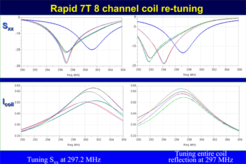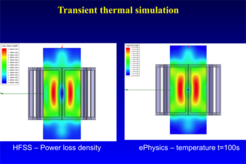Radio Frequency optimzation and safety
Human MRI studies conducted at high magnetic fields (7 T and above) operate in the regime where the wavelength of radio frequency (RF) fields inside an object is smaller than the object itself. Here the electrical (E) and magnetic (B1) components of the RF fields, as well as the specific energy absorption ratio (SAR) profiles in the object imaged (e.g. human head or body) are highly complex and spatially non-uniform. Reliable estimation of SAR values has become a very important concern. Lack of full knowledge is a major reason for overly conservative RF power limits provided by equipment manufacturers. It is impossible to measure SAR in-vivo, but reliable SAR values can be easily obtained from estimated E field data. Therefore numerical simulation is a very important component of MRI coil design and analysis, and safe control of SAR .
The design of MRI coils entails fully 3-dimensional near-field simulation. Our major goal is to generate uniform B1 fields while simultaneously reducing SAR. We can reduce RF non-uniformity by using dedicated MRI coil design approaches. These include distribution of capacitors, optimization of individual RF coil elements, and installation of multi-element arrays of transmit coils.



